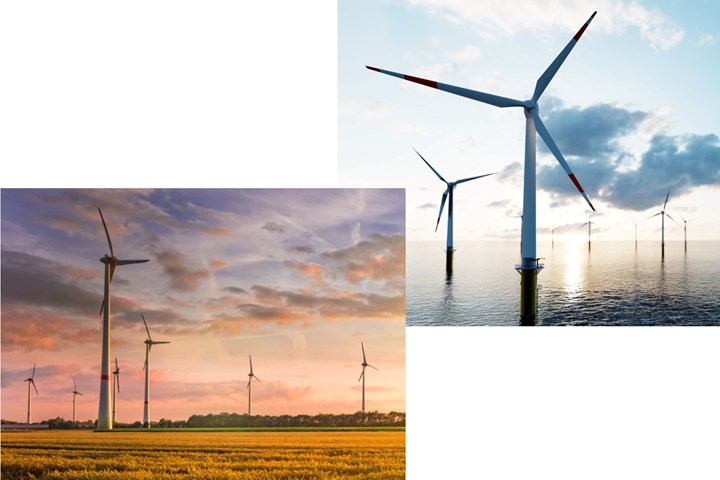North Sea countries target 260 GW of offshore wind energy; onshore wind shows reduced CO2 in U.S.
Nine EU countries agree to increased installations by 2050 for reduced CO2, a goal proven by a U.S. energy report, citing highest reductions in wind belt states.

As reported by , energy ministers from the nine members of the (includes Belgium, Denmark, France, Germany, Ireland, Luxembourg, the Netherlands, Norway, Sweden and the European Commission; the U.K. withdrew in January 2020) agreed to increase offshore wind deployment at their recent meeting in Dublin, Ireland. The new goal of at least 260 GW of offshore wind energy by 2050 will represent more than 85% of the EU-wide 2050 target of 300 GW.
“The green energy transition has only become more urgent since Russia’s invasion of Ukraine,” says Commissioner for Energy Kadri Simson. “The acceleration of renewables deployment is one of the three pillars of the REPowerEU Plan to end our dependence on Russian fossil fuels. Increasing renewable energy will not only help to improve the sustainability of our energy sector, it will improve our security of supply and the affordability of energy — two challenges that we are facing in the EU at the moment.”
“In Ireland alone, our sea area is seven times our landmass,” states Minister for the Environment, Climate and Communications Eamon Ryan. “The North Atlantic and North Sea comprise some of the windiest locations on the globe. It is our greatest collective resource of continuous energy, and it is momentous that we have agreed today to be ambitious in our targets, as a collective.” He noted the best way to realize that potential of offshore wind is to set agreed targets and operate as a collective. “With this approach, we can provide assurances to householders and businesses — in our own countries and across Europe — that firstly, Europe will be energy independent, and secondly, that these new renewable energy sources and resultant hydrogen from our seas will be fairly shared and, critically, will be affordable,” says Ryan.
also published highlights from the latest report by the (EIA), noting the carbon intensity of U.S. power generation fell 18% between 2016 to 2020, driven by a shift in the U.S. electricity generation mix away from coal and toward natural gas and renewables. The carbon intensity of power generation measures the amount of CO2 emitted to produce a unit of electricity. All but seven U.S. states decreased carbon intensity over that five-year period, although the amount varied state by state.
In 2020, the carbon intensity of U.S. power generation averaged 854 pounds of CO2/MWh, based on a carbon intensity of coal in the United States of 2,274 pounds of CO2/MWh, natural gas at 980 pounds of CO2/MWh and little to no emissions from nuclear, hydroelectric, wind and solar. The states with the lowest carbon intensities of power generation either have a large share of generation from renewables or a large combined share from renewables and nuclear. In 2020, Vermont had the lowest carbon intensity of power generation at 8.4 pounds of CO2/MWh, with almost all of its in-state electricity generation from renewables, but 60% sourced from Canada.
The five states with the largest reductions in carbon intensity between 2016 and 2020 (in pounds of CO2/MWh) were Tennessee (486), Maryland (477), Iowa (443), Kansas (371) and Oklahoma (348). Notably, the last three are located within the U.S. central wind belt.
Related Content
Honda begins production of 2025 CR-V e:FCEV with Type 4 hydrogen tanks in U.S.
Model includes new technologies produced at Performance Manufacturing Center (PMC) in Marysville, Ohio, which is part of Honda hydrogen business strategy that includes Class 8 trucks.
Read MoreInfinite Composites: Type V tanks for space, hydrogen, automotive and more
After a decade of proving its linerless, weight-saving composite tanks with NASA and more than 30 aerospace companies, this CryoSphere pioneer is scaling for growth in commercial space and sustainable transportation on Earth.
Read MoreWe4Ce infused 2.5-3-MW rotor blade design passes validation test
Composite rotor blade structure design by We4Ce, mold and prototype production by InDutch Composites and fatigue testing by Suzlon Group has resulted in the novel blade’s IEC61400-5:2020 certification.
Read MoreComposites end markets: Batteries and fuel cells (2024)
As the number of battery and fuel cell electric vehicles (EVs) grows, so do the opportunities for composites in battery enclosures and components for fuel cells.
Read MoreRead Next
Cutting 100 pounds, certification time for the X-59 nose cone
Swift Engineering used HyperX software to remove 100 pounds from 38-foot graphite/epoxy cored nose cone for X-59 supersonic aircraft.
Read MoreScaling up, optimizing the flax fiber composite camper
Greenlander’s Sherpa RV cab, which is largely constructed from flax fiber/bio-epoxy sandwich panels, nears commercial production readiness and next-generation scale-up.
Read MoreNext-gen fan blades: Hybrid twin RTM, printed sensors, laser shock disassembly
MORPHO project demonstrates blade with 20% faster RTM cure cycle, uses AI-based monitoring for improved maintenance/life cycle management and proves laser shock disassembly for recycling.
Read More












